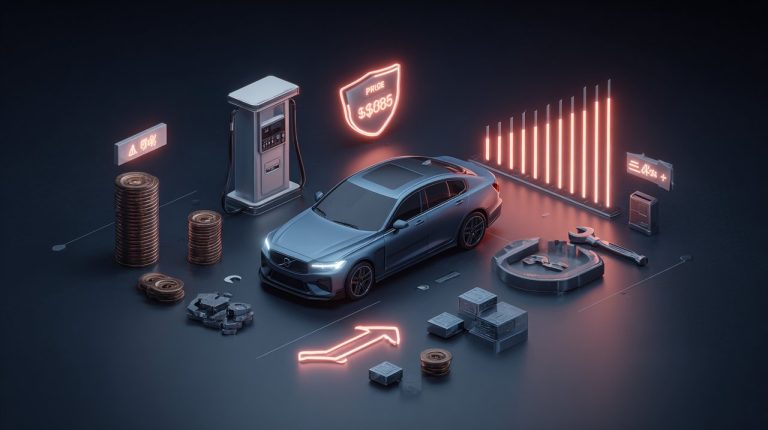Achieving true financial clarity can feel like building a complex system from scattered pieces. When it comes to our cars, costs often pop up out of nowhere, creating real financial headaches. In our experience, car ownership is one of the biggest blind spots for many people’s budgets. This guide is your practical roadmap. We’ll walk you through how to use the True Cost of Car Ownership Calculator to cut through that confusion, giving you a crystal-clear picture of what your vehicle really costs you (for a direct experience, access the calculator here True Cost of Car Ownership Calculator).

Deconstructing the ‘True Cost’: Beyond the Sticker Price
Think of it this way: the price tag on a car is just the admission ticket. To truly understand the cost of car ownership, you need to look far beyond that initial sticker price. This isn’t just about buying a car; it’s about owning a significant financial asset that comes with a network of ongoing obligations.
Many people only focus on their monthly loan payment or how much they spend on gas. But that’s just the tip of the iceberg! This narrow view often leads to budgeting surprises and unnecessary financial stress. A complete picture needs to include everything from day one until you sell or trade it in.
So, what are these often-missed costs? We’re talking about things like:
- Depreciation: The instant value loss the moment you drive off the lot.
- Insurance Premiums: Your ongoing safety net.
- Maintenance & Repairs: Routine care and unexpected fixes.
- Registration & Fees: The annual cost of keeping it legal.
- Fuel: Your regular trips to the pump.
- And even parking costs: Especially if you live in a city.
Ignoring these hidden expenses can really drag down your personal finances. The only way to get a genuinely informed view—whether you’re buying, selling, or just keeping your current ride—is to meticulously account for all these elements.
Blueprinting Your Inputs: Data Gathering for Precision
Just like any powerful tool, the True Cost of Car Ownership Calculator is only as good as the information you feed it. To get precise results, you need to systematically gather all the financial data tied to your vehicle. Think of this data collection phase as building the blueprint for your financial assessment—it ensures the calculator can do its job properly.
So, where do you start? Begin by identifying the core expense categories. These usually include:
- Your vehicle’s purchase price or current market value.
- Loan details like interest rate and term (if applicable).
- Your estimated annual mileage.
- Current insurance premiums.
- And your estimated yearly maintenance costs.
To guarantee accuracy, pull these specific figures directly from reliable sources. We’re talking about your loan agreements, insurance policies, and maintenance records. For variable costs, like fuel, track your consumption for a few months or use a solid average based on your driving habits. This careful approach helps avoid any “digital noise” that could skew your analysis.

Navigating the Calculator’s Interface: A Step-by-Step Workflow
Once you’ve got your data ready, actually using the True Cost of Car Ownership Calculator is pretty straightforward. It’s designed to make inputting your meticulously gathered information as smooth as possible. This step is all about the tactical workflow of data entry, ensuring your financial blueprint seamlessly transfers into the calculator’s engine.
Most calculators will guide you with clear fields, prompting you for specific details. Start by entering your vehicle’s make, model, and year. Then, move on to purchase details and any financing terms. Systematically work your way through sections covering insurance, fuel, and maintenance.
A common mistake we see is people rushing through these input fields or just guessing when precise data is available. Don’t do that! Take your time to accurately populate every field. Always double-check your figures before hitting submit, because even small errors can significantly throw off your final results.
Interpreting the Output: Unmasking Financial Friction Points
After you’ve entered all your data, the True Cost of Car Ownership Calculator will crunch the numbers and give you a comprehensive summary of your vehicle’s expenses. But this isn’t just a bunch of figures; it’s a diagnostic report that pinpoints where your financial “friction points” might be hiding in your car ownership. The real magic happens in how you interpret these insights.
Now, dive into the breakdown of costs. Ask yourself: Which categories are eating up the biggest chunk of your budget? Is it depreciation, or maybe those pesky unexpected repair costs? This detailed view helps you spot where your spending might be way off from your expectations or financial goals. For example, if you see high depreciation on a new car, it might make you consider a pre-owned alternative for your next purchase.
Clarity isn’t about avoiding complexity, but about gaining the ability to navigate it effectively.
With this data, comparing different scenarios—like keeping your current car versus buying a new one—becomes incredibly intuitive. The calculator transforms what often feels like a vague financial burden into clear, actionable insights. It empowers you to make smart decisions that actively reduce ongoing financial resistance.

The Calculator as a ‘Financial Integration Hub’: Weaving Data into Your Ecosystem
The True Cost of Car Ownership Calculator is far more than just a simple calculation tool. We see it as your central financial integration hub. It takes all those previously siloed vehicle expenses and connects them directly into your broader personal financial ecosystem, turning isolated data points into a smooth, cohesive financial flow.
Think of it like this: this calculator becomes a crucial node, pulling in bits and pieces from your insurance statements, service records, and loan documents. Then, it synthesizes all that fragmented data into one unified, easy-to-understand picture. This integrated view lets you clearly see how car ownership truly impacts your overall budget, your savings goals, and even your investment strategies. It’s about moving beyond just knowing the cost; it’s about understanding its ripple effects.
Once you grasp your vehicle’s true cost, you can then seamlessly feed this data into your budgeting software, financial planning spreadsheets, or even set up automated savings rules. For instance, if the calculator shows higher-than-expected maintenance costs, you might adjust your emergency fund contributions or create a dedicated ‘car maintenance’ sub-account. This kind of proactive integration helps minimize financial surprises and leads to a more robust, interconnected financial life.
Future-Proofing Your Ride: Strategic Scenario Analysis
The True Cost of Car Ownership Calculator isn’t just for understanding what you’re currently spending. It’s also an incredibly powerful tool for strategic scenario analysis. It allows you to literally “future-proof” your financial decisions around transportation. This proactive approach helps you anticipate potential changes and minimize future financial headaches.
We highly recommend using the calculator to model various “what-if” scenarios. For example:
- What’s the financial impact if you start driving significantly more miles per year?
- How does an older, less fuel-efficient vehicle stack up against a newer, more economical one over, say, five years?
- What are the implications of different financing options?
- Should you extend your current vehicle’s lifespan, or is trading up the better financial move?
This kind of foresight empowers you to make truly informed choices that align perfectly with your long-term financial objectives. By simulating different paths, you can pinpoint the most “financially ergonomic” option, ensuring your vehicle choices actively contribute to your overall financial well-being instead of creating unexpected burdens down the road.
Mastering the True Cost of Car Ownership Calculator truly transforms a complex, often confusing part of personal finance into a clear, manageable piece of your overall financial blueprint. As we’ve seen, by embracing this tool as a powerful financial integration node, you’re not just looking at numbers. You’re gaining a seamless, friction-free understanding of your vehicle’s real economic impact.
So, what are you waiting for? Start leveraging this insight today. It’s the practical step you need to build a more harmonious and integrated financial future.
💡 Frequently Asked Questions
The calculator's main goal is to provide a clear and comprehensive understanding of a vehicle's actual cost, extending beyond its initial purchase price, to help manage financial implications and avoid budgeting surprises.
Beyond the sticker price, the true cost includes depreciation, insurance premiums, maintenance and repairs, registration and fees, fuel, and potential parking costs.
Accurate use requires inputting data such as the vehicle's purchase price or market value, loan details (if applicable), estimated annual mileage, current insurance premiums, and estimated yearly maintenance costs, ideally sourced from reliable documents.
The calculator helps by identifying financial "friction points," allowing for strategic scenario analysis (e.g., comparing different vehicles or financing options), and integrating vehicle expenses into your overall budget and financial strategy for smarter decision-making.








